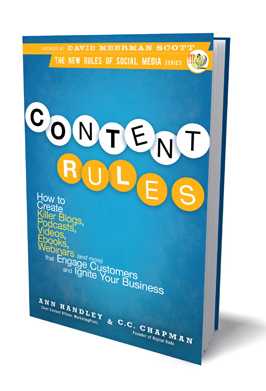 My mother used to justify her massive collection of cookbooks by saying that a volume was worth buying if there was just one outstanding recipe in it. By that metric, pages 157-168 of Content Rules are worth the cover price alone. I thought I was pretty savvy about creating content, but authors C.C. Chapman and Ann Handley gave me at least a couple of dozen new ideas. This is a practical and useful book that every marketer who’s struggling with the new world of democratized publishing will find of value.
My mother used to justify her massive collection of cookbooks by saying that a volume was worth buying if there was just one outstanding recipe in it. By that metric, pages 157-168 of Content Rules are worth the cover price alone. I thought I was pretty savvy about creating content, but authors C.C. Chapman and Ann Handley gave me at least a couple of dozen new ideas. This is a practical and useful book that every marketer who’s struggling with the new world of democratized publishing will find of value.
Chapman and Handley start out with a list of terms that they would like to see banished from the marketing vocabulary, including “leverage,” “proactive,” ”solution,” “drill-down” and “drink the Kool-Aid.” They have good reasons for hating these buzzwords, and I winced to realize that several regularly turn up in my own writing. The authors practice what they preach, though. This book is written in clear, declarative and hype-free language. It bubbles with enthusiasm for the topic and its recommendations are the kind you can take to the bank (there goes another buzzword).
Chapman and Handley are clearly fans of great writing, and it shows in their use of simple language and playful asides that inject a human touch when the text strays into the realm of the academic. They even invented a few new words, such as “re-imagine” as an alternative to the more mechanical “re-purpose.” Early on, they pay homage to Strunk & White’s Elements of Style, prompting me to haul out that 105-page masterpiece and re-acquaint myself with the beauty of simple language.
Pages 157-168 lay out 25 rules for successful webinars. As a veteran of more online events than I can count, I found at least 10 great ideas here. For example, how about taking audience questions during the webinar rather than at the end? Or promoting the event with a short podcast? Follow up with an e-mail inviting follow-up questions. Post the whole thing on SlideShare. Why didn’t I think of those?
Content Rules doesn’t pretend to be a visionary treatise on the future of social media. There are plenty of books out there that do that. This is a hands-on guide that’s meant to be marked up, so bring a highlighter. The book includes practical tools like the worksheet that Kodak uses to stimulate ideas from prospective bloggers and tips on where to find free art to dress up blog posts. It will even help you decide when to use in-house content experts and when to contract for those services (though some payment guidelines would have been helpful there).
The authors tracked down many new case studies to provide a welcome break from the Zappos and Blendtec examples cited so frequently elsewhere. For example, there’s Sears Yard Guru, which helps potential buyers of lawnmowers choose equipment, and Army Strong Stories, which tells of military life in the words of soldiers in the field. There’s even a chapter devoted to B2B marketing, an often overlooked category that the authors assert can be just as innovative as the consumer marketing sector.
There’s even advice on how to write headlines that are catchy but not cliché. For example, compare “Insights from Social Media Research” to “The Naked Truth: What’s Hype, What’s Not in Social Media.” Both can describe the same content, but which do you think is more likely to grab attention?
Throughout the book, Chapman and Handley encourage marketers to think big and take chances. Attracting attention on the crowded social Web isn’t about playing it safe, they say, so get comfortable with risk. “I’d worry less about shocking customers than I would about boring them,” says Jellyvision founder Harry Gottlieb in one notable quote.
Content Rules isn’t a book for corporate strategists or CEOs. It won’t give you great insight about what’s coming down the social media road. But it doesn’t pretend to do these things. This is a disarmingly informal, friendly and approachable book that you will want to keep on your desk and consult when the creative muse has fled you, as it does all of us at times. As a recipe for content, it would have made my mother proud.
